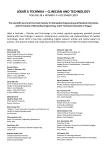NANOFIBERS FROM POLYVINYL ALCOHOL AND CAN ENLARGE THE SET OF TRAPPED ODOROLOGICAL TRACES
Authors:
Martin Kralovic; Bruno Sopko; Petr Novotny; Evzen Amler
Published in:
Lékař a technika - Clinician and Technology No. 4, 2018, 48, 131-135
Category:
Overview
We tested collecting abilities of nanofibers prepared from polyvinyl alcohol and calcofluor (PVAC) for an odorological trace collection. Our study revealed that spectrum of odorological traces trapped on nanofibrous PVAC adsorbents, is more stable and reproducible compared to commonly used ARATEXTM. In addition, both PVA and PVAC nanofibers can adhere a large number of traces undetectable by ARATEX. Our results show that functionalization of commonly used adsorbent ARATEXTM with PVA and PVAC nanofibers can vastly increase the accuracy of trace collection and, thus, significantly improve forensic investigations.
Klíčová slova:
chitin – chitosan – forensic mycology
Sources
- Peterson, J., Garges, S., Giovanni, M., McInnes, P., Wang, L., Schloss, J. A., Bonazzi, V., McEwen, J. E., Wetterstrand, K. A., Deal, C., Baker, C. C.: The NIH human microbiome project. Genome Res., 2009; vol. 19, no. 12, pp. 2317–23.
- Grice, E. A., Segre, J. A.: The skin microbiome. Nat. Rev. Microbiol. 2011; vol. 9, no. 4, pp. 244.
- Findley, K., Oh, J., Yang, J., Conlan, S., Deming, C., Meyer, J. A., Schoenfeld, D., Nomicos, E., Park, M., Kong, H. H, Segre, J. A. Human skin fungal diversity. Nature. 2013; vol. 498, no. 7454, pp. 367.
- Grice, E. A., Kong, H. H., Conlan, S., Deming, C. B., Davis, J., Young, A. C., Bouffard, G. G., Blakesley, R. W., Murray, P. R., Green, E. D., Turner, M. L.: Topographical and temporal diver-sity of the human skin microbiome. Science. 2009; vol. 324, no. 5931, pp. 1190–1192.
- Rennie, P. J., Gower, D. B., Holland, K. T., Mallet A. I., Watkins, W. J.: The skin microflora and the formation of human axillary odour. Int J Cosmet Sci. 1990; vol. 12, no. 5, pp. 197–207.
- Seidl, V.: Chitinases of filamentous fungi: a large group of diverse proteins with multiple physiological functions. Fungal Biol Rev. 2008; vol. 22, no. 1, pp. 36–42.
- Hartl, L., Zach, S., Seidl-Seiboth, V.: Fungal chitinases: diversity, mechanistic properties and biotechnological potential. Appl. Microbiol. and Biotechnol.. 2012; vol. 93, no. 2, pp. 533–543.
- Monheit, J. E., Cowan, D. F., Moore, D. G.: Rapid detection of fungi in tissues using calcofluor white and fluorescence micro-scopy. Arch. Pathol. Lab. Med. 1984; vol. 108, no. 8, pp. 616–618.
- Vyplelová, P., Vokálek, V., Pinc, L., Pacáková, Z., Bartoš, L., Santariová, M., Čapková, Z.: Individual human odor fallout as detected by trained canines. Forensic. Sci Int. 2014; vol. 234, pp. 13–15.
- Pinc, L., Bartoš, L., Reslova, A., Kotrba, R.: Dogs discriminate identical twins. PLOS One. 2011; vol. 6, no. 6, e20704.
Labels
BiomedicineArticle was published in
The Clinician and Technology Journal

2018 Issue 4
Most read in this issue
- GLOBAL CENTERS OF MEDICAL DEVICE TECHNOLOGY: UNITED STATES, EUROPE AND CHINA
- Computer-aided modeling and additive manufacturing fabrication of patient-specific mandibular implant
- Nanofiber scent carrier
- Immediate effect of physical on blood flow velocity in radial artery in young adults
